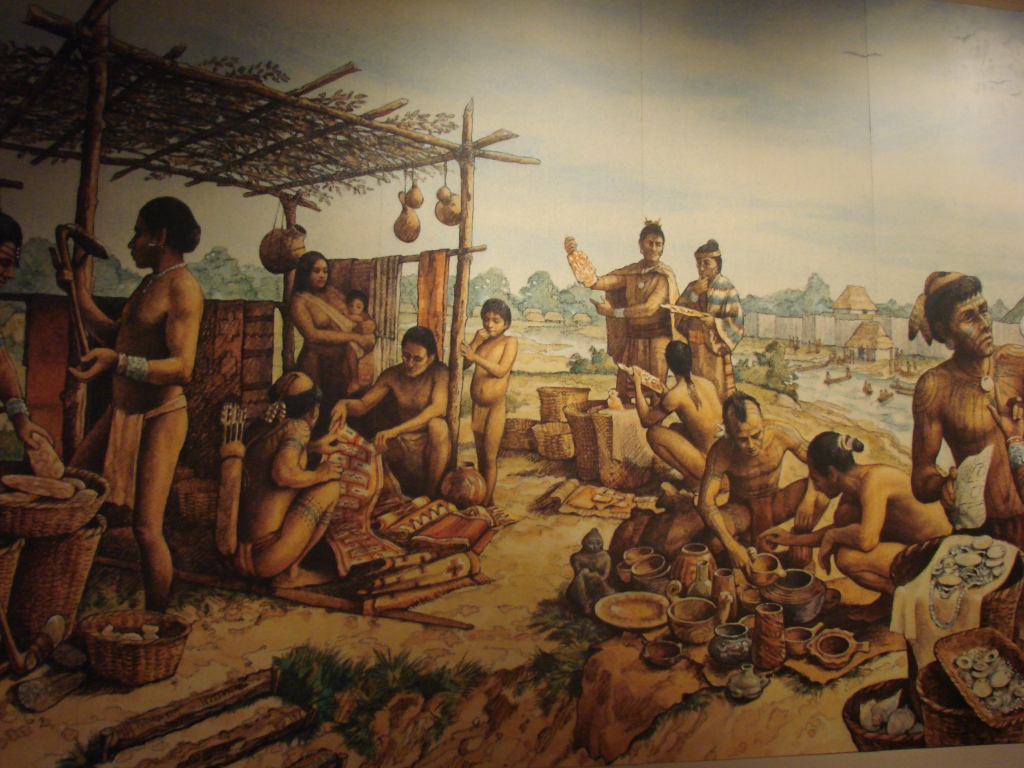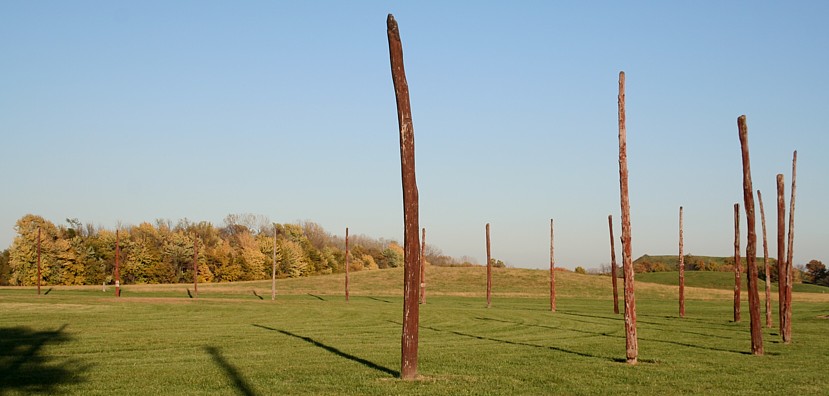
Cahokia Birdman Tablet found in 1971 at Monks Mound
In all my time living in Illinois I never imagined that my home would be located in such close proximity to a World Heritage Site and that it would only take me a couple of hours drive to get there; no lodging nor airfare required.
As you’ll see in my blog, I’m fascinated and love writing about Native American culture. I journeyed to places where Native American culture left footprints and where I can serve as a voice to tell their story.
Luckily for this important Heritage Site, I didn’t need to dig deep to find information. Since its discovery in the early 1900s, the state of Illinois has done a very good job at making information about the site readily available to the public. If you’re interested in visiting the famous Indian Mounds, as they are better known for, I highly recommend you check out Illinois’ Cahokia Mounds webpage. There you will find a great video called City of the Sun which gives a brief synopsis about this site and about the vibrant culture and amazing people who called this sophisticated city their home.
Cahokia is located about nine miles east of downtown St. Louis, Missouri, in a Midwest city called Collinsville. It is one of the most interesting Native American Historic sites whose remnants left curious archeologists wondering about what happened to this extraordinary civilization who inhabited this land long before the arrival of the Europeans.
Cahokia is a modern and sophisticated indigenous site named by local historians in honor of the Cahokia subtribe of the Illiniwek aka Illinois tribe who moved into the area in the 1600s[1]. Archeologists now call the native inhabitants of this settlement Mississippians. However, what the ancient inhabitants called themselves and this city is still unknown.

illustration of Cahokia’s marketplace found at Cahokia Mounds State Historic Site
What is really amazing about this historic site is that a very sophisticated and powerful civilization once lived in the area archaeologists call the Mississippi River bottom land of southwestern Illinois and its surroundings. If you think you have to travel long distances to learn about the great civilizations like the Mayan and Egyptians, dig a little deeper and you might find out the treasures that are hidden in your own backyard.
Why didn’t people know about these historic and archeological sites until recently? This is the question I asked the tour guide as I was listening attentively to the tour. Cahokia was discovered in the early 1900s and agencies in Illinois carried out the first scientific investigations of the area in the 1920s, when finally the true extent of what this stunning culture left behind was discovered.
What you will find in Cahokia
Monks Mound – Home of the Mississippian Chief
You will see the remnants of one of the most impressive civilizations that once called Cahokia their home. The people who lived here erected impressive earthen mounds covering up to 14 acres and rising as high as 100 feet. The most famous of these earthen mounds is the Monks Mound, which is one of the largest and most impressive mounds. This mound is categorized as a temple of religion and government. The Monks Mound is the largest mound measuring 100 feet high and 955 feet long. Just to give you a mental image Monks Mound is roughly the same size at its base as the Great Pyramid of Giza. No wonder the Monks Mound in Cahokia is considered the largest Pre-Columbian earthwork in the Americas and the largest pyramid north of Mesoamerica. According to archaeological investigations platform mounds were used to support wooden structures such as temples, dwellings of the elite, tribal council lodges, and charnel houses. Monks Mound supported a wooden structure on the summit and it is believed to be the home of the great chief of the Mississippians.

View of Monks Mound
Remains of a Mississippian Ruler
If you get a chance to take one of the guided tours at Cahokia, ask the tour guide about Mound 72. To me, this is the second most interesting mound at Cahokia, next to Monks Mound. In 1967, archaeologists began digging Mound 72, a six-foot high ridgetop mound which turned out to be a burial mound. What archaeologists found here is not as interesting as the intricate and high level detailed work that was found at this burial. Archeologists found that Mound 72 was built over three small mounds covering surface burials and a series of burial pits. They found a number of grave goods numbering in the tens of thousands and also the remains of nearly 300 people, including young men and women, some of whom appear to have been sacrificed, and the skeleton of an early leader resting on a blanket of 20,000 shell beads. Standing before the re-creation of the burial of this early Mississippian ruler laying there on a blanket of shell beads makes me think of the intricate and time consuming work in which the Egyptians also honored their dead. The level of detail and work just proves how important the afterlife was to the culture of these ancient Native Americans.

early Mississippian ruler on a blanket of 20,000 shell beads
The Famous American Woodhenge
To some visitors, perhaps one of the most fascinating things to see and learn about at Cahokia is the famous American Woodhendge named like this to distinguish it from similar structures in England. Dr. Warren Wittry was doing excavations here when he observed that numerous large oval-shaped pits seemed to be arranged in arcs of circles. He theorized that posts set in these pits lined up with the rising sun at certain times of the year, serving as a calendar, which he called woodhenge. How did this work? On the first day of each season, the sun lined up with specific poles on the circle. And on the all important spring and fall equinoxes, which signaled the time to begin preparing for planting and harvest, the sun appeared to rise from Monks Mound, home of the chief, believed to have been the brother of the Sun.

Reconstruction of Woodhenge found at Cahokia Mounds State Historic Site, photo by jqjacobs.net
Why Visit Cahokia?
The United Nations Educational, Scientific, and Cultural Organization (UNESCO) didn’t just name Cahokia Mounds State Historic Site a World Heritage Site for no reason, not only does this site help us understand more about North American prehistory but it also reminds us that a powerful civilization thrived here in Illinois. Most people are familiar with the great civilizations of Mexico, the Mayas, Egyptians and Mesopotamian but we rarely hear about civilizations such as the powerful Mississippians. Despite the amazing success of the Mississippians’ civilization they are not considered as technically developed as the Mayans or the Egyptians because of one simple but important detail—they didn’t have written language.
Despite this fact, I still argue that this civilization and what they left behind will help us understand more about ourselves as both individuals and as a society. The million dollar question that most archeologists still theorize about, one that remains a mystery to this day, is what happened to this once powerful civilization? Once again, scholars argue that depletion of resources contribute to the city’s decline. War, disease, social unrest, and declining political and economic power may also have contributed to their decline.
In one of my previous trips to Montezuma Castle National Monument in Arizona I pose the same question, why did these tribes leave their home and what became of them. Regardless of the answer, Cahokia was and will remain one of the most important archaeological discoveries in the Western Hemisphere in the north of Mexico.

If you do travel to the Midwest to see this amazing heritage site, I have a few recommendations for you.
- Most visitors would categorize Cahokia as a cultural museum, but this site is more than just a museum. Cahokia does have an Interpretative Center which like any other museum has artifacts behind glass displays and exhibits, but that’s where the similarities end.
- I definitely recommend you take advantage of the guided tours offered by the museum as the tour guides are very knowledgeable about the Cahokia Mounds and most importantly they are locals from Illinois who can tell you more about good restaurants and the kind of stuff that visitors and tourists need to know when traveling to this Midwest state.
- You will not experience Cahokia Mounds if you don’t go outside and see for yourself the 2,200 acres of the site and admire the monumental architectures. Do breathe and feel the air that the Mississippian people shared at one point.
- Cahokia is the kind of place where you have to travel comfortable with your sneakers on and ready to do some climbing. If you only get a chance to drive by Cahokia Mounds very close to five o’clock when the museum closes, run up to see the famous Monks Mound, the highlight of this heritage site. The view from this tall mound is breath-taking, you will be able to see the St. Louis Missouri’s Gateway Arch and while you’re at it take a selfie with the Gateway Arch in the background!
I encourage you to ask me questions and do share on my blog how your trip went. You can also share your thoughts about your trip by leaving a comment on this post or share your pics and any interesting facts on Aculturame’s Facebook page.
Tlazocamatli (Náhuatl for Thank you)
[1] Found on http://cahokiamounds.org/learn/
© Lizzeth Montejano and Aculturame, 2012-2021. Unauthorized use and/or duplication of this material without expressed and written permission from this blog’s author and/or owner is strictly prohibited. Excerpts and links may be used, provided that full and clear credit is given to Lizzeth Montejano and Aculturame with appropriate and specific direction to the original content.
If you are interested in any of my work (including pictures, text content, etc.) you can contact me at aculturame@gmail.com
If you would like to request permission to use any of my blog content please contact me at aculturame@gmail.com
Such a fascinating ancient site! I had never heard of this place before, let alone its status as one of the World Heritage Sites in the U.S. Visiting places like this always makes me imagine how life was like when they were still inhabited or used, and what triggered their decline. Thanks for the invaluable information, Liz!
Thank you for your comment Bama, Cahokia Mounds is a must-see and one that is not likely to have a lot of tourists because of its remote location. Definitely recommend a trip there!
I just added this blog to my feed reader, excellent stuff. Can’t get enough!
[…] Her blog, Aculturame is very interesting with several posts catching my attention. One in particular was about Cahokia. […]